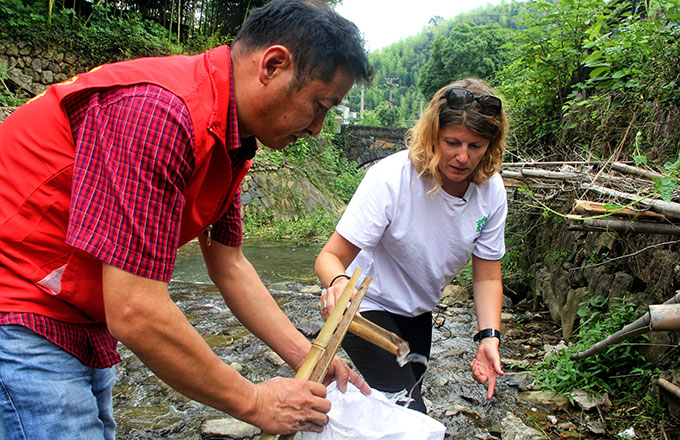Change comes quickly to southernmost city
 |
|
A resident dries sea cucumbers on a Zhaoshu Island beach last year. The island is part of Sansha, Hainan province. [Photo by Zhao Guanyu/Xinhua] |
Report given by Xi Jinping bolsters people's hopes for lasting prosperity
MA ZHIPINGThirty-year-old Feng Yibing, the third generation of a fishing family on Yongxing Island-the seat of Sansha, China's southernmost city-said he is sure of a brighter future after listening to General Secretary Xi Jinping's report to the 19th CPC National Congress on Wednesday.
"Xi said China will accelerate its development as a marine country, and I believe this will create more opportunities for us to develop ourselves and enjoy a better life while making a contribution to the country," said Feng, who changed his job from fisherman to port worker.
The city government is encouraging people to shift from sea-based livelihoods to the service sector in a bid to reduce nearby fishing and protect reef resources.
Li Qiansan, a fisherman who is preparing to move to a new two-story steel-frame house on Yongxing-a small tropical island-said he was excited about Xi's remarks, as they will likely boost local development.
"I'm expecting more changes to come, though tremendous changes and improvements have already come to Sansha over the past five years," he said.
Sansha, the country's youngest prefecture-level city, located about 2,680 kilometers from Beijing, was created in July 2012 to administer islets, sandbanks and reefs in the Xisha, Zhongsha and Nansha island groups, as well as 2 million square kilometers of surrounding waters in the South China Sea.
Zhao Heng, a village official taking care of 38 households on Yongxing, said the message on marine development from the 19th National Congress gave him more confidence for leading fishermen to set up other businesses.
"Xi's report on accelerating marine development has greatly inspired government officials and the local people," said A Dong, who was elected mayor of Sansha in July after years of service with the State Oceanic Administration.
Residents acknowledge the earthshaking changes that have taken place in the past five years on Yongxing and neighboring islets, including housing, daily needs, communications, transportation, green space and environmental protection projects.
To preserve Sansha's environment, treatment plants for trash and sewage were the first to be built. More than 2.5 million beach cabbages, coast oaks and beach morning glories have been planted on the islands. A number of seawater desalination projects, with a daily capacity of 13,000 metric tons, have been built to satisfy basic local needs.
The city welcomed its first regular charter flight in December to serve public servants and their relatives, as well as fishermen and workers in Sansha, in addition to the launch of three cruise liner routes in the past several years.
Sansha I, the largest and most advanced vessel yet to commute between the island province of Hainan and islets in the South China Sea-launched in September 2014-makes the round trip to Haikou on the island's north coast once a week. The roll-on, roll-off vessel can accommodate up to 456 people and carry 20 standard container trailers.
The city is now searching for opportunities offered by the 21st Century Maritime Silk Road, part of China's Belt and Road Initiative. The hundreds of islets in Sansha can serve as platforms for services in maritime trade and industry, officials say.



















